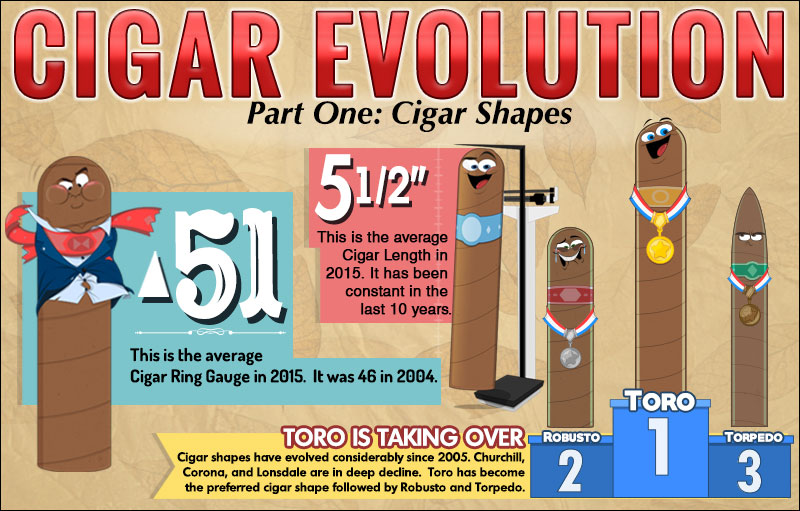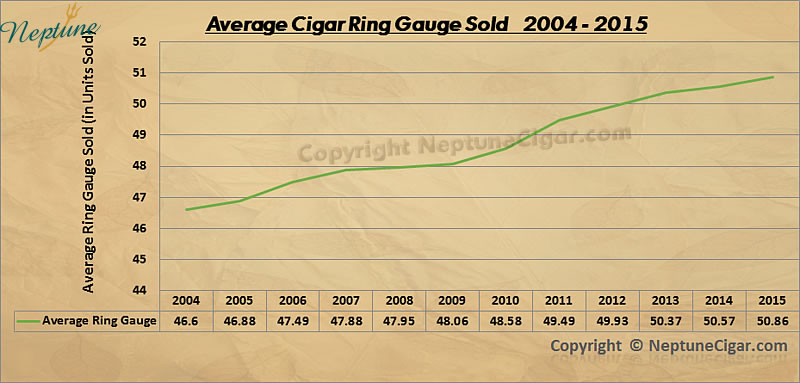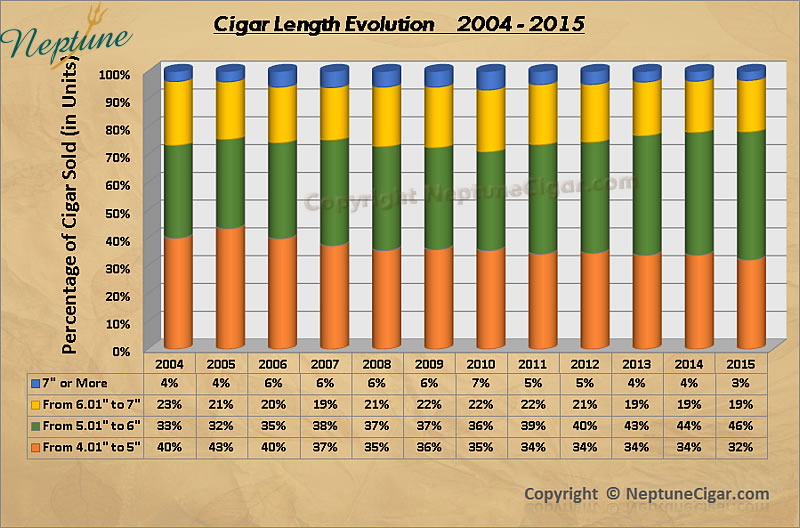We've been analyzing our sales of cigars per shape, ring gauge and length and have found some interesting facts. This study is based on the number of cigars sold between 2004 and 2015 at our retail locations as well as through our online store. We did not include small cigars (cigarillos that have ring gauge of 33 or less), as the main goal of this study is to observe the evolution of premium cigar shapes in the last decade. Here are the surprising results:

- Average Cigar Ring Gauge has increased by 4 points in the last 10 years!
Yes, in fact, cigar diameter has increased by 1/16’’ since 2004, when the average ring gauge of cigar sold was 46.6 (Diameter=46.6/64’’) and is now, in 2015, 50.86 (Diameter=50.86/64’’).
Until 1999, cigars with ring gauge over 54 were considered novelty cigars and major brands didn’t usually have these cigars in their portfolio. Ernesto Carrillo started the trend in 1999 with his popular La Gloria Cubana Serie R with ring gauges from 52 up to 60. As the years passed, customers got used to larger cigars with popular brands such as Oliva's NUB in 2011. Even Cubans, who usually stick to traditional cigar shapes, released the Cohiba Behike in 2006 with a ring gauge of up to 56. In 2012, Ernesto Carrillo gets back into the XL cigar market with the famous INCH with ring gauges reaching 70. Christian Eiroa and Tom Lazuka raised the bar even higher with the very popular brand Asylum, releasing cigars with ring gauges of up to 80. As you will see on the graph below, the trend is very solid and we wouldn’t be surprised to see a 90 cigar ring gauge soon!

The graph below confirms the fast growing segment
of premium cigars with ring gauges of 55 and more. In only 10 years, cigars with a ring gauge over 55 have taken 16% of the market while cigars with ring gauges of less than 50 have lost 26% of the market share. Ring gauges between 50 and 55 now
represent half of the market.
- Preferred Cigar length is between 5 and 6 inches.
In fact, this segment has grown by 40% in the last decade, now representing 46% of the market. Cigars shorter than 5” have lost their first place but still represent the second largest segment with 32%. Cigars over 6” have lost 20% of their market share since 2004 and represent 22% of the market.

- Cigar Shapes: Robusto and Toro represent 62% of the Total Market.
Yes! The big winner is the Toro vitola which has grown by 300% to now represent 30% of the total cigar market in 2015. Robusto and Toro account for 62% of the total market in 2015. As the two previous graphs show, aficionados tend to prefer 5’’ to 6’’ cigars with larger ring gauge. The big losers are the Churchill, a one-time popular shape, which has lost 14% of the total market; the Corona, which has lost 10% of market, and the Lonsdale (also called Lancero), which manufacturers tried to revive in 2013-2014, lost 4%. It now represents only 3% of the total market. We also note that the Torpedo has gained 5% of market in the last 11 years to represent 13% of the market in 2015.
To completely understand that study, we used the old Cuban classification for cigar shapes below which is the most “official” definition for the shapes. In this study, we only considered the top 6 shapes of cigars.
Traditional Cuban Cigar Shapes Defined:
- Churchill: This large corona is traditionally 7 inches by 48 ring. Length can vary from 6 3/4 to 7 7/8 in length by 46 to 50 ring.
- Cigarillos: The classic cigarillo is 4 inch by 26 ring but can be anywhere under 6 inches and 29 ring.
- Corona: The corona size is typically 5.5 inches with a ring gauge of 40 to 44.
- Corona Extra: A Corona Extra (traditionally a 5 1/2 inch by 46 ring gauge) can range from 4 1/2 to 5 1/2 inches by a 45 to 47 ring gauge.
- Double Corona: Double Coronas are usually 6.75 to 8 inches long by a 49 to 54 ring.
- Giant: The Giant was typically a 9 inch by 52 cigar. Today, it is every cigar 8 inches and up with a ring gauge of 50 and up.
- Giant Corona: A Giant Corona typically is 7.5 inches and up by 42 to 45 ring.
- Grand Corona: The classic Grand Corona size is 6 1/2 inches by 46.
- Long Corona: The classic Long Corona is 6 inch by 42 ring but can go from 5 7/8 to 6 3/8 inches by 40 to 44 ring.
- Long Panatela: The classic Long Panatela is 7 1/2 inch by 38 ring but can go from 7 and up inches by 35 to 39 ring.
- Lonsdale: The standard Lonsdale is 6.5 inches long by a 40 to 44 ring.
- Panatela: This once very popular thin format can go from 5 1/2 to 6 7/8 inches long by 35 to 39 ring gauge.
- Perfecto: The Perfecto shape has two tapered, closed ends with a rounded head, a closed foot, and a bulge in the middle. They can vary in length and ring gauge.
- Petit Corona:The classic size of this short corona is 5 inches by a 40 to 44 ring gauge, but it can be as short as 4 inches.
- Pyramid: The Pyramid differs from the Torpedo in that it flares continuously from the head to the foot in a triangle shape.
- Robusto: The Robusto is a short Churchill size, traditionally 5 to 5.5 inches by a 50 ring gauge.
- Short Panatela: The standard Short Panatela is 5 inch by 38 ring but can go from 4 to 5 3/8 inches by 35 to 39 ring.
- Slim Panatela: Traditionally, the slim panatela is 6 inch by 34 ring but can go from 5 to more inches by 30 to 44 ring.
- Small Panatela: Traditionally, the small panatela is 5 inch by 33 ring but can go from 4 to 5 inches by 30 to 34 ring.
- Toro: The standard Toro shape is 6 inches by 50 ring.
- Torpedo: The Torpedo was traditionally a fat cigar with two closed, tapered ends. Today, it is any cigar with a cut foot and straight body which tapers to a closed, pointed head.

To conclude with this study, we clearly see that cigars are getting fatter while maintaining a length between 5 and 6’’. Thinner ring gauge shapes like Corona, Churchill and Lonsdale are losing their share mainly due to their smaller ring gauge. Toro is definitely a size to keep watching. That’s it for the first part of our Cigar Evolution Study. Next, we’ll talk about Strength, Origin and Tobacco!